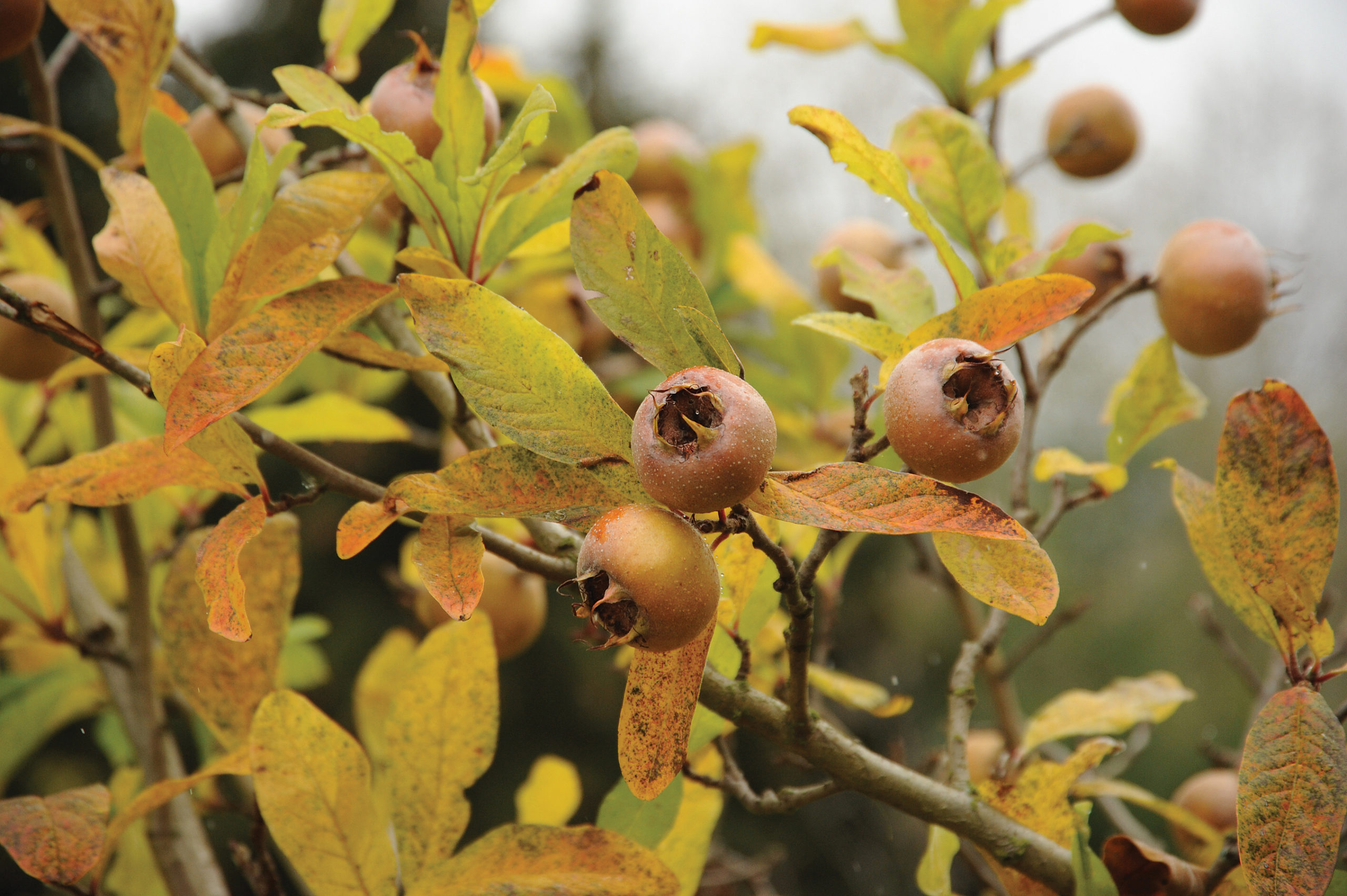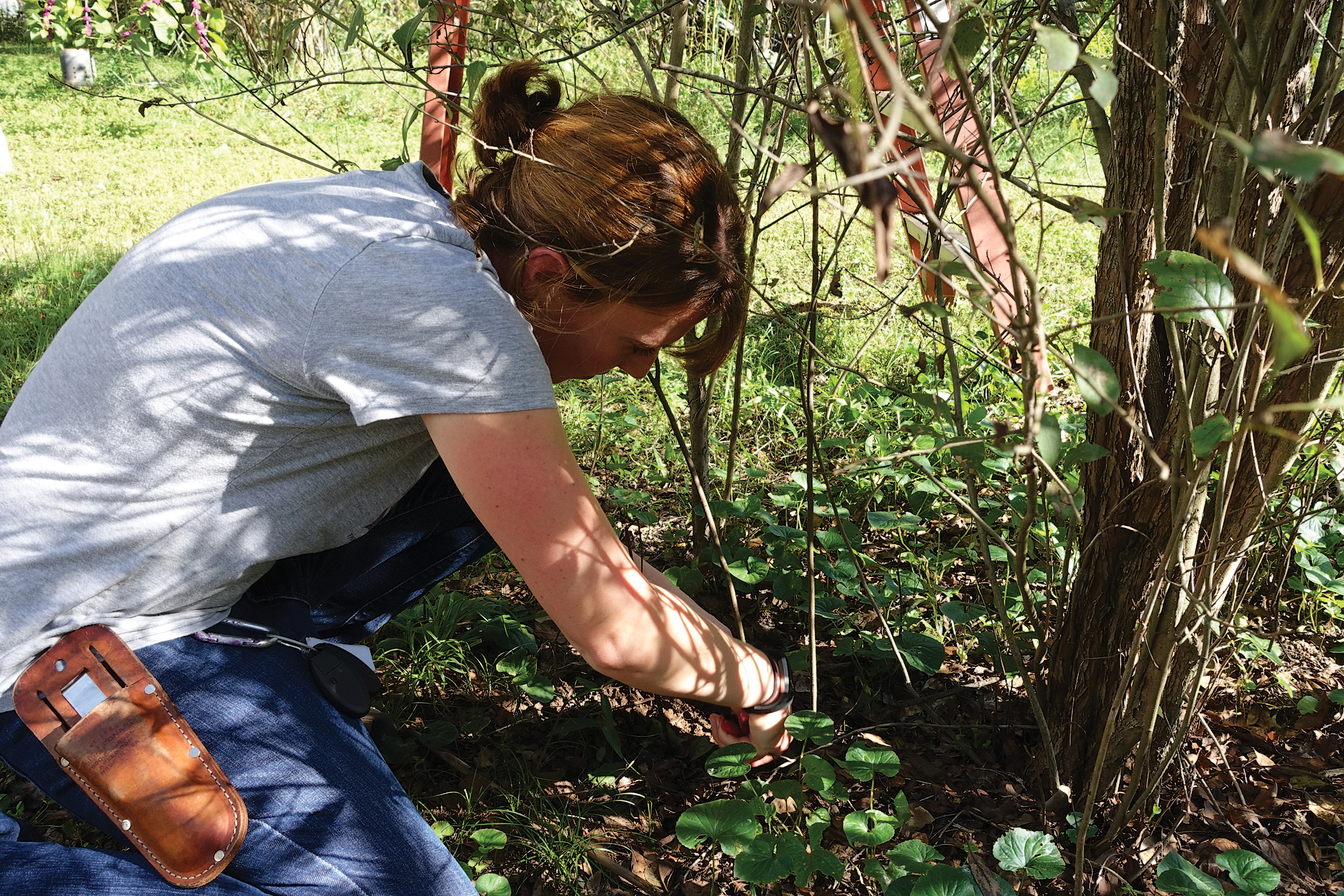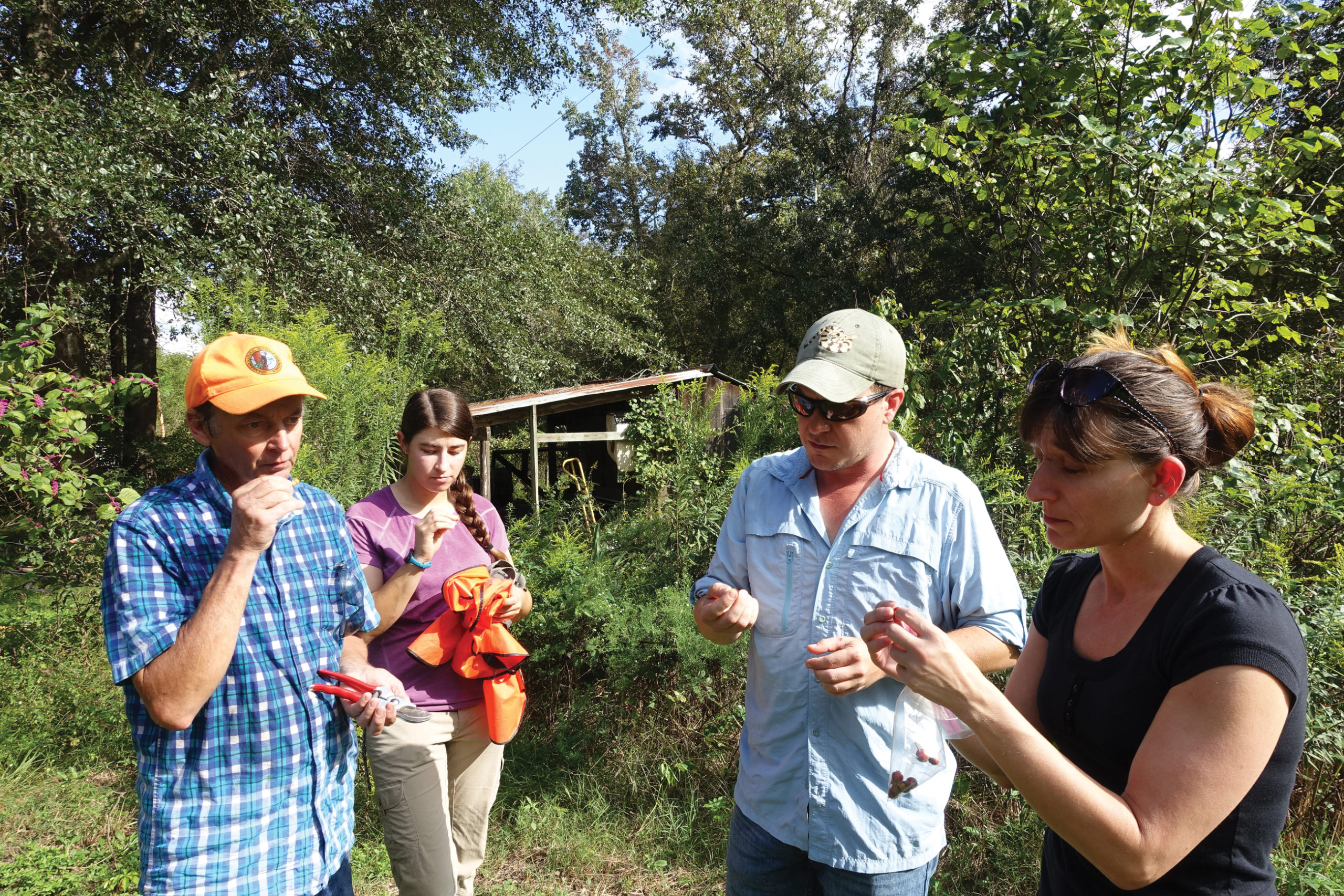This is an account of a meddling medlar that placed an inquisitive thorn in the side of Jane Ellenbogen Stern, an environmentalist from Pine Bluff, Arkansas. In 1969, Stern was leading a bird-monitoring project at a small remnant of tallgrass prairie and bottomland woods about fifty miles northeast of her home—a natural area now preserved within an expanse of rice fields and aquaculture ponds. She noticed an unusual plant that resembled a hawthorn (Crataegus), only shrubbier, which was covered in white flowers. She collected a branch sample and notified regional biologists, including Edwin Burnell Smith, the curator of the University of Arkansas Herbarium. Stern’s discovery triggered the interest of an entourage of plant professionals, who spent nearly a half century attempting to provide a proper identification and name. The plant is now recognized as an unusual naturally occurring hybrid and is known as Stern’s medlar (×Crataemespilus canescens).


In October 2018, Plant Growth Facilities Manager Kea Woodruff and I eagerly followed Stern’s trail to gather propagules from her rare find, during our Arnold Arboretum plant collecting expedition to Arkansas and Oklahoma, which we nicknamed the A-OK expedition. The expedition was part of the Arboretum’s Campaign for the Living Collections, a ten-year initiative to collect nearly four hundred taxa from around the globe. We reached out to staff at the Arkansas Natural Heritage Commission in the summer of 2018 to prepare for our upcoming expedition. Theo Witsell, a botanist and ecologist at the commission, explained that Stern’s medlar is protected, and as such, we would not be permitted to harvest propagules from the only known wild population growing at the Konecny Grove Natural Area, located in Prairie County. Witsell, however, connected us to his friend Tom Frothingham, a former commission staff member, now of the Little Rock Zoo. Frothingham had obtained a Stern’s medlar from the Natural Resources Conservation Service’s Plant Materials Center in Booneville, Arkansas, a decade prior. That plant, in turn, had been propagated from the Konecny Grove. Frothingham wrote to Woodruff that, in addition to having a large specimen growing in his yard, he had already potted up a division. “You’d be welcome to it,” he wrote, and he also volunteered that we could dig additional divisions.
Woodruff and I planned to be near Little Rock during the initial two days of our nine-day expedition, so we arranged to visit Frothingham directly after our six-hour flight (with layover) on October 1. We obtained our rental car and drove forty-five minutes in the unanticipated afternoon heat, starting in the bustling city of Little Rock and continuing through the serene and rural landscapes northwest of the city. We then zeroed in on his address and proceeded to the end of the wooded side road. “Mine is the second driveway, with the mailboxes,” Frothingham had instructed. We found our spot.
An Unexpected Discovery
Born in Little Rock, in 1918, Jane Ellenbogen Stern moved to the suburb of Pine Bluff at about age thirty, with her husband, Howard Stern, and their two children, Arthur and Ellen. Stern developed a long-standing love of the outdoors through birdwatching, which she became passionate about while Arthur was obtaining his Boy Scout nature badge. As her hobby advanced, she became a charter member of the Jefferson County Audubon Society. Coincidentally, Stern was searching for a small bird, the Traill’s flycatcher (Empidonax traillii), when she first encountered the medlar. The Traill’s flycatcher is now more commonly known as the willow flycatcher. It had been previously documented in the low, moist tallgrass prairies of eastern Arkansas, and Stern was directed to the Konecny Prairie and Grove—then unnamed and unprotected—which was one of the few remnant prairies remaining in the region. In 1951, a nesting study had documented flycatchers at the site and found that out of the fifteen nests that were discovered, thirteen were in presumed hawthorn trees. One can speculate that the “hawthorns” may have been an initial sighting of Stern’s medlar.
In the summer of 1968, Stern first visited the property, searching for the flycatcher with Raymond McMaster, the manager of the White River National Wildlife Refuge, and Thomas Foti, who would later be appointed senior ecologist for the Arkansas Natural Heritage Commission. Sam Konecny, the owner of the property, showed them around. “We piled into Mr. Konecny’s new car and roared off, helter skelter, across the farm, stopping occasionally to leap out and pull a ‘weed’ while battling off mosquitos and sweltering in the heat,” Foti later wrote in the Ozark Society Bulletin. The remnant landscape was divided into two sections— a seventy-one-acre rectangle of tallgrass prairie, which had been preserved as a hayfield (Konecny Prairie), and a twenty-two-acre grove of swampy woods (Konecny Grove), known as slash timber, which included overstory species like persimmon (Diospyros virginiana), green ash (Fraxinus pennsylvanica), and honey locust (Gleditsia triacanthos). Along the edge of this woodland were the hawthorn-like thickets in which the flycatchers nested.


The following winter, Stern was contacted by Douglas James, a professor of zoology at the University of Arkansas, who asked her to organize an effort to determine when the Traill’s flycatcher arrived at the grove. The reason for the effort was due to uncertainty about flycatcher taxonomy. Ornithologists increasingly believed the Traill’s flycatcher should be treated as two species, rather than one, but they were uncertain which species deserved the original scientific name, which was based on a bird John James Audubon had observed in Arkansas. The song is considered the best way of distinguishing between the two species. The population that was already known to breed in Arkansas sang “fitz-bew,” but the population that sang “wee-be-o” had previously not been reported to nest in the state. Due to Stern’s experience and proximity to the site, she was the ideal individual to lead the effort. She was eager for the challenge. “We will do our best to cover the Konecny place,” she wrote to James on February 26, 1969. “If the fiz-bew one hollers as loud as the spit-chee and che-bek and wee-bee-o, I don’t see how anyone could miss him.”
Several months later, the “Traill’s Flycatcher Vigil” commenced. Stern assembled twenty-seven birdwatchers to take turns observing the grove daily, beginning March 29, to determine when the flycatchers arrived to roost. On May 6, Stern was on the lookout with Jewel Herring, another birder from Pine Bluff, when they heard one of the flycatchers singing, and the song was “fitz-bew.” On July 7, Foti and Stern returned and found an empty nest, assumed to be a Traill’s flycatcher’s, burrowed in a branch of a hawthorn-like shrub. Stern observed that the plant did not appear like other hawthorn species in the grove, and so she sent a sample to Edwin Burnell Smith, the curator of the University of Arkansas Herbarium. Stern would ignite a decades long process of pursuing an accurate name for the plant, even while the confusion around the flycatcher taxonomy was resolved. The “wee-be-o” species, commonly known as the alder flycatcher, was given the official name of Empidonax alnorum in 1973.
The Search for a Name
On July 10, 1969, Smith wrote to Stern with an initial classification of the mystery plant. “I must say, [this is one] of the most difficult plants I’ve received for identification,” Smith wrote. “The small tree is a type of Crataegus, ‘Hawthorn,’ in the Rose Family. The genus Crataegus is cursed with a very complex taxonomy which makes the individual species quite difficult to identify. The one you sent in is probably (and I emphasize probably) Crataegus engelmannii.” As Smith was unsure of his initial naming, he solicited an additional sample and offered another stab—hillside hawthorn (C. collina). Smith even mailed an herbarium sheet to the Arnold Arboretum for assistance, likely due to the reputation of Charles Sprague Sargent, the Arboretum’s founding director, as an expert on hawthorn taxonomy. Director Richard Howard responded to Smith on October 23 with a complicated assessment: it appeared to be a “mixed collection.” The flowering stems looked like red chokeberry (Aronia arbutifolia), and Howard agreed that the fruiting stems (obtained that fall) resembled C. collina. “Unhappily,” Howard wrote, “the specimens lack the young leaves and flowers which are equally critical for accurate determination.”
Correct identification was proving to be exceedingly difficult, and the only sense that could be made was that Stern was harvesting samples from multiple plants. However, in a letter to Stern on June 8, 1970, Smith suggested an alternate explanation for the “enigmatic ‘Haw’”—the possibility of “a strange hybrid of some kind.” But then, after studying additional collections, Smith was relieved to finally provide the name of dotted hawthorn (Crataegus punctata). Dotted hawthorn is very similar to C. collina, and is occasionally considered the same species. “Well, finally (!) I am able to report to you with great relief that I have been able to determine the frustrating ‘haw,’ at least to my satisfaction,” Smith wrote to Stern on October 15. “It turns out that the plants are not a new species or a hybrid, which is kind of sad after all the trouble we have both gone to.”
Later, upon reexamination of specimens for the Vascular Flora of the Southeastern United States in the 1980s, taxonomists rejected Stern’s medlar as a hawthorn. Although the flower and fruit characteristics are similar to hawthorns, as is the overall plant height, hawthorn leaves are shallowly to deeply lobed, unlike the simple, subentire leaves of Stern’s medlar. Also, hawthorns typically grow as small trees with one large stem, occasionally producing suckers, while Stern’s medlar is a large shrub with equal-diameter shoots. Taxonomist James B. Phipps, of the University of Western Ontario, was intrigued by the anomalous specimens, and contacted Smith in 1988. Phipps had been researching hawthorn taxonomy since the 1970s, and years later, he would author the hawthorn section of the Flora of North America. Smith relayed the news to Marie Locke of Pine Bluff in a letter dated July 13, 1988. “I recently heard some interesting news from a botanist in Canada: He plans to name a new species (and new genus, for Arkansas) in the Rose family from collections made several years ago by Jane Stern,” Smith wrote. “I think that this is the plant I had such difficulty identifying—remember it? It had two strikingly different kinds of leaves on it.”




Stern was later in contact with Phipps herself. She agreed to collect additional herbarium specimens in mid-September, when the fruit would be ripe, and she also promised to arrange for Phipps to visit the Konecny property himself. On October 21, a group of Arkansans, including Stern, escorted Phipps to the coveted shrubs. Phipps ultimately published a new name for the plant in 1990: Mespilus canescens. He recognized that although Stern’s plants resembled hawthorns, other characteristics uniquely resembled common medlar (Mespilus germanica), the singular species within that genus, which is native to southeastern Europe and Iran. Among other things, it shared a multi-stemmed habit; distinctive leaf venation, with secondary veins curving toward the margins; and fine, white (canescent) hairs on the inflorescence. While even this comparison didn’t match completely—the common medlar, for instance, produces larger brown fruit, unlike the red fruit of Stern’s discovery—Phipps suggested that a hybrid origin seemed unlikely, given the lack of suitable parent species. “The most likely explanation of the status of M. canescens is that it is an ancient relic,” Phipps wrote. “One should always be cautious in describing a new species from such limited material (all the cited collections come from the same locality), but M. canescens is so distinct from all other native American Maloideae that there can be no doubt that it is not a previously described North American member of this subfamily.” In the same paper, the shrub was aptly given the common name of Stern’s medlar.
But the story was not over. Almost twenty years later, Eugenia Y. Y. Lo and colleagues further investigated the relationship of Stern’s medlar to the common Eurasian medlar. Through DNA amplification and phylogenic analyses of over ninety Rosaceous species, including hawthorn, chokeberry, crabapple (Malus), medlar, and serviceberry (Amelanchier), they concluded that although Stern’s medlar shares a common ancestor with the Eurasian medlar, it is more closely related to blueberry hawthorn (Crataegus brachyacantha)—a species whose range is centered in Louisiana, eastern Texas, and southern Arkansas. Their analyses, published in 2007, suggested a hybrid origin of Stern’s medlar, with blueberry hawthorn as the maternal parent. Because the fruit of blueberry hawthorn is fittingly blue, however, the authors acknowledged that another native red-fruited hawthorn (or even an ancient, now extinct medlar species) may have been involved in past hybridization.



The authors surmised that common medlar and blueberry hawthorn may have hybridized if they were cultivated within range of one another. Hawthorns are known to hybridize, and the authors pointed to literature confirming that common medlar was, indeed, cultivated in an agricultural station in Louisiana as far back as 1893. Furthermore, Slovak, the small town two miles north of Konecny Prairie and Grove, was home to at least fifty families of Eastern European heritage by 1909. Immigration to Arkansas in the mid- to late-nineteenth century was encouraged by advertising, legislation, and aid from government agencies, private land corporations, and the railroad industry. Perhaps the families in Slovak had brought along plants or seeds of a favorite fruit? Common medlar has been cultivated as far back as the ancient Romans.
Phipps accounted for these new conclusions, and in 2017, he reclassified Stern’s medlar as ×Crataemespilus canescens. The ×Crataemespilus nothogenus was created in 1899 to accommodate an assumed hybrid, ×C. grandiflora, originating from midland hawthorn (Crataegus laevigata) and common medlar, that was also initially described as medlar. In 1914, a second hybrid was discovered: ×C. gillottii, an intermediate between English hawthorn (Crataegus monogyna) and common medlar. Now Stern’s medlar has joined the ranks as the third member of this hybrid genus.
An Unconventional Collection
The taxonomic and conservation status of the Stern’s medlar initially placed this plant on the radar of the A-OK expedition. When Woodruff and I pulled into the driveway at Tom Frothingham’s property, northwest of Little Rock, we were greeted by him and two colleagues, Lauren Goldstein and Connor Livingston. Woodruff and I could hardly contain ourselves as Frothingham led us from the driveway to where the specimen was planted, out in full sun, between the shed and house. The shrub was vigorous—it was nearly fifteen feet tall—and I thought its habit resembled that of a serviceberry or large rose (Rosa)—upright with slightly cascading branches. After months preparing for the A-OK expedition and a day’s worth of travel, it was surreal that our target was in plain sight. To add to our excitement, the medlar was fruiting!

Frothingham and I alternated ascending the ladder to gather the cherry-sized pomes, which were relatively sparse. After we collected a handful, Frothingham insisted that the whole group sample one, to which we all curiously obliged. The shiny red fruit was surprisingly sweet, and Woodruff and I saved all the seed from the consumed fruit to send back to the Arboretum’s Dana Greenhouse for propagation. I then slowly walked around the specimen and found an appropriate division to dig. Frothingham lent me a trowel for the job. After the division was successfully dug and bagged, Frothingham then led us to the promised potted plant, harvested as a division several years prior, at the front of his house. We chatted about seed propagation and the rich history of the plant for a while, before Woodruff and I loaded up our bounty. We repeatedly thanked our collaborator for his generosity, and we backed out of his driveway, delighted about how successful the first day of the expedition had been.
Preserving an Unusual Hybrid
Not only is Stern’s medlar a rare hybrid but it is visually appealing to boot. In September 1989, Stern wrote to Harold Grimmett, then the director of the Arkansas Natural Heritage Commission, urging him to request that Phipps withhold the location of the Stern’s medlar in his 1990 paper. “The plant is extremely attractive in appearance and can be expected to be aggressively sought by the horticultural trade,” Stern wrote. Phipps, in response, suggested that the commercial threat seemed “highly unlikely” and noted that the location was already well-documented with herbarium specimens. Nonetheless, Phipps agreed with Stern’s assessment of the plant’s beauty. In his book Hawthorns and Medlars, published in 2003, Phipps states that “Stern’s medlar is arguably the most exquisite ornamental treated in this book.” Its exfoliating bark has hues of cream and olive, and he describes the plants as “a fountain of white flowers.” I personally like to imagine that this attractive nature is the reason that Stern initially took such keen interest in the plant—launching a pursuit that continued well beyond the Traill’s flycatcher.

In fact, the medlar has proved to be a conservation boon for Konecny Prairie and Grove. From the beginning, Stern recognized the significance of this site as the only remaining Traill’s flycatcher’s nesting habitat in eastern Arkansas and as one of the few tallgrass prairie remnants that escaped plowing in the region. Stern awakened a movement to preserve the prairie and grove, and in February 1976, the grove became the first conservation easement purchased by the Arkansas Natural Heritage Commission. This was a victory for so many, and on May 14, 1977, a gathering was held on the Konecny land to celebrate, which coincided with the Traill’s flycatcher arrival. A decade later, however, the flycatcher migrated elsewhere to nest, and the landowner told Stern that he was interested in reclaiming the property. “So many things connect with the Konecny prairie, the grove, the bird, and the Tree,” Stern wrote to Phipps on April 24, 1989. “Bless the bird for hanging on long enough for the Commission to purchase the easement on the grove … He would have plowed some or all of it … but you and The Tree have put an end to that idea.”
Stern’s medlar is now graded as critically endangered, which means it has an extremely high risk of extinction in the wild. Only twenty-four individuals are known to exist, and because Stern’s medlar is triploid (having three sets of chromosomes), it is likely sterile. This means the seeds we collected from Frothingham’s specimen will be difficult (if not impossible) to germinate. As hawthorns have been found to produce seed through apomixis (asexual seed formation), however, hope for potential seedlings is well-founded. Regardless, the clonal division that we harvested, as well as the potted plant that Frothingham provided, are thriving at the Dana Greenhouse production facility. In two to three years, they will be added to the Arboretum’s living collections to join the other 179 taxa in our landscape that are of conservation concern. I am proud to have brought Stern’s medlar to the Arboretum with Woodruff, to have the opportunity to learn of Stern’s tireless conservation efforts, and to have experienced, first-hand, what Phipps devoted his entire career to—the complicated identification of hawthorns, medlars, and their hybrids.
Works Cited
All archival correspondence and images were provided courtesy of the Jane E. Stern Collection, University of Central Arkansas Archives (M90-02, Series II, Sub-Series IV, Box 1, Files 12–17), Torreyson Library, University of Central Arkansas, Conway, Arkansas.
Foti, T. 1971. The grand prairie. Ozark Society Bulletin, 5(4): 6–11.
Freeman, F. D. 1948. Immigration to Arkansas. The Arkansas Historical Quarterly, 7(3): 201–220.
Kesterson, K. 2019. Jane Rita Ellenbogen Stern (1918–1989). In CALS Encyclopedia of Arkansas. Retrieved from https://encyclopediaofarkansas.net/entries/jane-rita-ellenbogen-stern-421/
Joshi, V. K., and Attri, B. L. 2017. Specific features of table wine production technology. In Kosseva, M. R., Joshi, V. K., and Panesar, P. S. (Eds.), Science and Technology of Fruit Wine Production (pp. 295–461). Cambridge, MA: Academic Press.
Leslie, J. W. 2000. Stern, Jane Rita Ellenbogen. In Williams, N. A., and Whayne, J. M. (Eds.), Arkansas Bio-graphy: A Collection of Notable Lives (pp. 274–275). Fayetteville: University of Arkansas Press.
Lo, E. Y. Y., Stefanovic, S., and Dickson, T. A. 2007. Molecular reappraisal of relationships between Crataegus and Mespilus (Rosaceae, Pyreae)—two genera or one? Systematic Botany, 32(3): 596–616.
Meanley, B. 1952. Notes on nesting Traill’s flycatcher in eastern Arkansas. The Wilson Bulletin, 64(2): 111–112.
Phipps, J. B. 1990. Mespilus canescens, a new Rosaceous endemic from Arkansas. Systematic Botany, 15(1): 26–32.
Citation: Enzenbacher, T. 2019. A Medlar by Any Other Name. Arnoldia, 77(1): 16–25.
Phipps, J. B. 2016. Studies in Mespilus, Crataegus, and ×Crateamespilus (Roseaceae), I. Differentiation of Mespilus and Crataegus, expansion of ×Crataemespilus, with supplementary observations on differences between the Crataegus and Amelanchier clades. Phylotaxa, 257(3): 201–229.
Phipps, J. B., Kennon, N., and Lance, R. 2003. Hawthorns and medlars. Portland: Timber Press.
Vaughn, M. 2015. Hawthorn: The tree that has nourished, healed, and inspired through the ages. New Haven: Yale University Press.
Tiffany Enzenbacher is the manager of plant production at the Arnold Arboretum.
